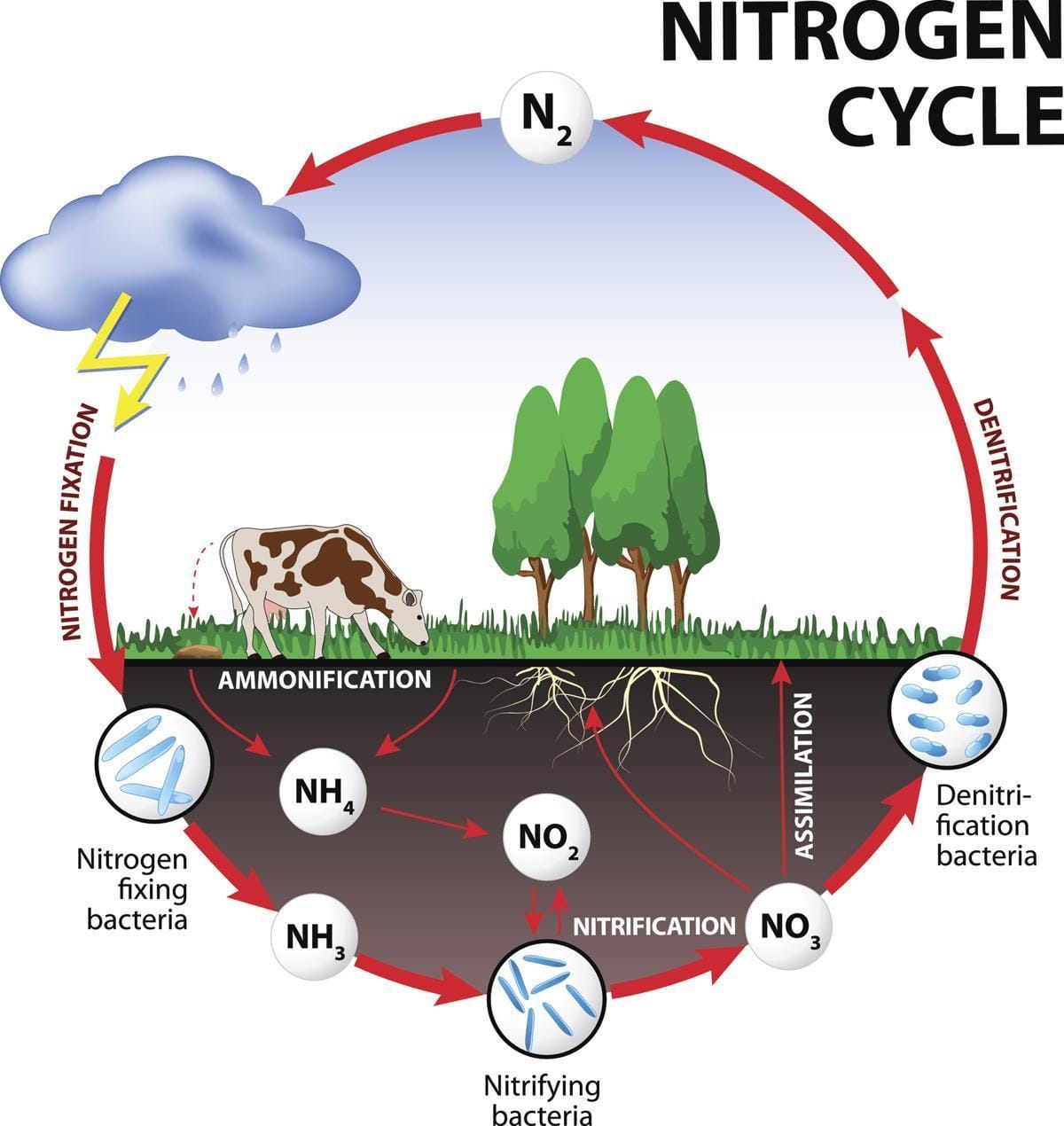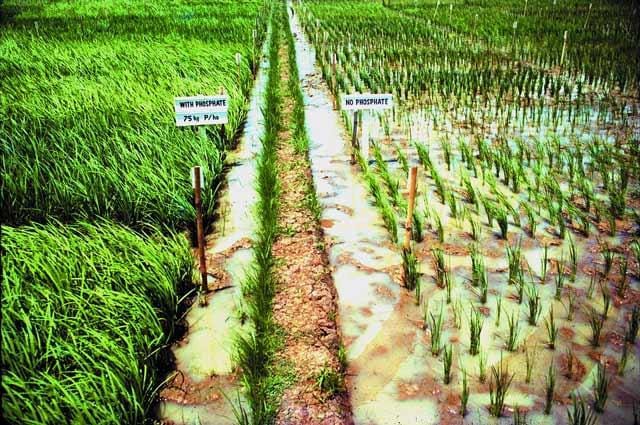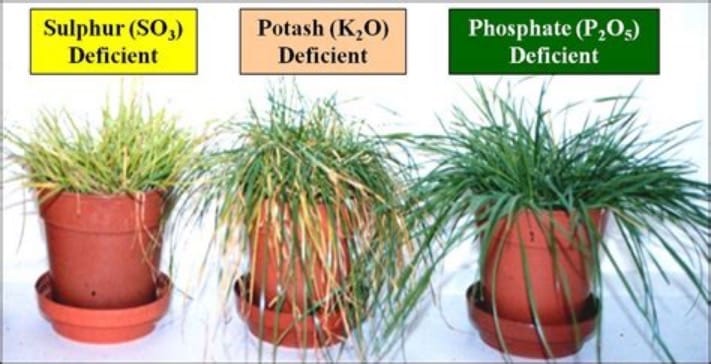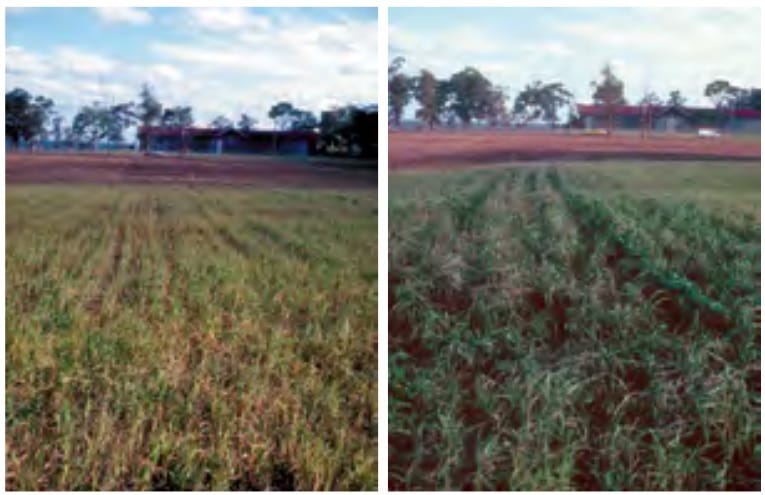Volumes have been written about soil fertility and how to fertilise your pasture the right way.
However, most information out there isn't written for dairy farmers. It doesn't tie the link to how proper fertiliser management leads to better production and profits. So we wrote this concise two-part guide.
In part 1, we spoke about nutrients, how proper fertiliser management can lead to better profits and the four biggest soil-fertiliser limiting factors.
Now, in part 2, we’ll cover the major & minor nutrients and its sources in more detail. We’ll also talk about how to identify various nutrient deficiencies in your pasture.
The major nutrients and its sources
Nitrogen – N
Pastures respond strongly to nitrogen. So, if you want your intensively grazed pasture to be productive, you should have a sound Nitrogen management plan.
The three main sources of nitrogen (N) are:
- N fixing bacteria often found in leguminous plants such as clover.
- N entering your farm via external feed and animal effluents.
- N from synthetic and organic fertilisers.

Nitrogen is mainly concentrated in the root zone of plants. So, to get accurate N results, use soil test samples that reach at least 60 cm or more below ground level.
Also, N can quickly evaporate into thin air. So it would be best if you got your soil samples tested immediately. Suppose that's not possible, store your soil samples in an air-tight bag inside your fridge. That’ll prevent N loss.
There are also a few visual indicators to help you gauge Nitrogen deficiencies in your soil: For example, if your pasture appears patchy or pale and shows more growth around urine patches, it’s likely to indicate N deficiency.
Similarly, soils that have a very low organic matter or are very sandy tend to be N deficient.
To a large extent, you can manage N through a mix of legumes and fertilisers. However, be aware that excessive use of N can quickly increase the acidity of your soil and this, in turn, disturbs the balance of nearby water bodies.
The most commonly used N fertilisers are urea, ammonium sulphate and MAP (mono ammonium phosphate) and DAP (di-ammonium phosphate).
These fertilisers are broken down to nitrates, a form that plants can use readily. Also, N applications are most effective when the soil is moist. Dry soils can prevent N uptake. So getting your timing right is equally important.
In some cases, when N fertilisers over a long period, can make your pastures sulphur deficient. Because studies show that correct N fertilisation can increase DM yields by two to three times.
Phosphorus - P
Australian soils are mostly deficient in phosphorus. Mainly due to erosion. In general, some soils bind well with phosphorus, while others don't. This P binding ability is also called phosphorous sorption. The soils with poor phosphorous sorption often require more P in the form of fertilisers.
Performing the Colwell P soil test once every two or three years is an effective way to measure how much phosphorous is available in your pasture soil. Your soil has enough P if this test result exceeds 85mg/kg.

Popular P fertilisers include superphosphate, mono ammonium phosphate, di-ammonium phosphate, rock phosphate and poultry litter.
P fertilisers are more expensive than other fertilisers. So farmers use this sparingly only when needed. However, intensively grazed pastures might need even an annual application. Liming acidic soils may also increase P availability and binding ability.
More ground cover means more P availability and less P leaching. So do maintain adequate ground cover and a few trees that can mine P deposits from deeper depths.
Finally, most P fertilisers also contain cadmium and fluorine in small amounts. And it can be harmful to plants and animals. So take care not to avoid excess P fertilisers.
Potassium - K
Potassium is usually abundantly available in most soils and growing plants store K.
However, you can lose a lot of K after your hay or silage harvests. So return as much organic matter as possible back to your soil, either directly as organic waste or indirectly via effluent waste or compost.
Regular soil testing is an effective way to measure potassium levels in your paddocks. When results are exceeding 4% potassium, you know that you have abundant potassium in your soil. Adequate exchangeable potassium value ranges between 0.3–0.6 me/100g.

However, excess K can cause health problems for cattle during pregnancy and lactation. Excess K also reduces magnesium intake by plants.
Your most common potassium fertiliser for pastures is potassium chloride (muriate of potash). You can also use the more expensive forms of potassium nitrate or potassium sulphate. But excessive use can make your soil salty.
Also, most plants accumulate soil potassium in excess. This is often called ‘luxury consumption’. To avoid this, don’t apply K in spring or during calving. Instead, choose to add during autumn or late spring. And take care to graze your pastures only after four weeks of applying K.
Sulphur - S
Plants can absorb sulphur in a sulphate form. Pastures are sulphur deficient since grazing removes this nutrient from the soils. Also, there is a rise in usage of fertilisers with small amounts of sulphur.
Annual soil testing is your best way to determine the sulphur availability on your pasture. At times a plant tissue test is required. The adequate level of extractable sulphur in a soil test is 5–8 mg sulphur/kg.
To avoid nitrate poisoning, you need to maintain an N (10 to 15 parts) is to S (1 part) ratio. Sorghum forage crops are low in sulphur and stock grazing these may require additional feed supplements.

Your most common Sulfur fertiliser for pasture is the 'single superphosphate'. Elemental sulphur, though not readily water-soluble, can also work well.
Gypsum gives you both sulphur and calcium, and sulphur coated urea gives you sulphur and nitrogen. You also may not need to apply sulphur at all, if your soil has a long history of superphosphate applications.
Calcium - Ca
Calcium occurs abundantly in most soils and groundwater sources. You can find calcium mainly in lime, gypsum and dolomite.
The soils that are high on exchangeable calcium are crumbly and ideal for plant growth. Calcium deficiency is rare in plants. But Ca is a vital component of animal health.

Calcium can get depleted with repeated, intense applications of urea or di-ammonium phosphate. Because both don’t contain calcium. Loss of calcium also occurs when you remove plants as hay or silage.
However, a good mix of legumes can prevent this from happening, because legumes contain four times more calcium than grass.
In case you need to supplement Ca, you could consider agricultural lime (calcium carbonate), dolomite (calcium-magnesium carbonate), or even gypsum (calcium sulphate).
Other products like superphosphate, poultry litter, blood and bone, ash or even rock phosphate also work. For acidic soils, consider adding gypsum.
Magnesium – Mg
Magnesium is abundantly found in most soils and groundwater. Soil magnesium deficiencies are rare, with acid sandy soils being the most deficient in magnesium.
If your pasture has high potassium or the plants have high nitrogen levels, magnesium deficiency can occur in livestock. In early spring, the uptake of Mg by plants is low and needs to be supplemented as feed to livestock.
Magnesium moves slowly in your soil when water drains through the soil and does not pose much of an erosion or runoff hazard.
Annual soil testing is the best method to measure the available magnesium in your soils and identify deficiencies.
The ideal exchangeable magnesium for pastures is 1.6 me or more per 100g. In addition to this, if needed, you can do plant tissue tests to identify magnesium supplements for livestock.
In case you need to supplement Mg you can consider Dolomite (magnesium and calcium carbonate) that you can finely grind for faster soil reaction or magnesium oxide or the more soluble potassium magnesium sulphate (Epsom salts).
Magnesium fertilisers are slow to act on soils. Since magnesium fertilisers react slowly with the soil, you need to apply them ahead of time, maybe in autumn for your spring growth.
Replenishing Essential Trace Nutrients
In addition to these six nutrients, good plant and animal production also need a few more essential nutrients such as copper, zinc, manganese, boron, molybdenum, cobalt and iron in tiny quantities.
But soil tests alone cannot tell you if your soil has these trace minerals or not. Instead, a few visual assessments can help you spot deficiencies.
That said, some fertilisers also add trace minerals. For example, Mo-superphosphate has molybdenum; Borax provides boron and copper, or zinc sulphate fixes low levels of copper or zinc in your soil.
Liming benefits your pasture by adding more increases molybdenum and reducing both cadmium and magnesium. However, liming also reduces copper, boron and zinc, so you might need to replenish them.
Because these trace elements can leach easily, you need to add organic matter, nutrients and animal manure to your soil to help it retain these trace minerals.
Nutrient deficiencies in dairy pastures
So far, we spoke about covering your bases in terms of soil nutrients. However, beyond this, some soils might still be deficient in one or more nutrients. Here are some visual indicators that can help you identify these specific nutrient deficiencies.
- Nitrogen (N) deficiencies: yellowish pastures, strong growth around urine patches
- Phosphorus (P) deficiencies: leaves curl and get stunted or in some cases leaf tips brown
- Potassium (K) deficiencies: blotches or strong brown scorch marks on leaves
- Sulphur (S) deficiencies: young leaves turn yellowish, looks similar to N deficiency.
- Calcium (Ca) deficiencies: leaf tips become dry, brittle, black (sometimes) and eventually die
- Magnesium (Mg) deficiencies: leaves look pale, especially between veins,
- Manganese (Mn) deficiencies: yellowish areas between the leaf veins, veins look pale
- Copper (Cu) deficiencies: leaves may look pale or in some cases appear brown or stunted
- Iron (Fe) deficiencies: young leaves look pale, and at times almost white
- Boron (B) deficiencies: may prevent lots of legumes from setting seed and result in a low legume ratio
- Cobalt (Co) deficiencies: hard to differentiate between N deficiency, same symptoms, low legume growth
- Molybdenum (Mo) deficiencies: cupping of leaves and distorted stems are a big indicator
- Zinc (Zn) deficiencies: stripes of pale areas in leaves, leaves can turn whitish and die in extreme cases
In addition to the above visual indicators, you might also want to confirm your analysis using a plant tissue test. This will tell you what nutrient is deficient and by how much.
That brings us to the end of part 2 of this three-part series on fertilising your pastures the right way. Next, in part 3, we cover how to identify nutrient deficiencies in your dairy cows and how you can create a precise fertiliser-nutrient management plan for your dairy farm.
If you have any questions, please shoot them as a comment below. I’ll personally answer them for you. Otherwise, check out our other pasture management information.
Until we meet again, Happy Farming!
- The Dedicated Team of Pasture.io, 2020-10-21